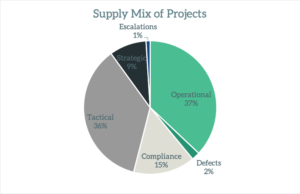Too many strategic initiatives and too little time

A common scenario in a medium-sized corporation looking to finalize their annual plan. A list of 120 proposed strategic IT initiatives and an executive suite in gridlock over priorities. The situation additionally escalated by an aggressive 50% revenue growth target for 5 years.
A recent CIO change saw IT reach out to the business in an attempt to become partners and had successfully established an executive council, so the correct forum for the discussion was present. Attempts at scoring models to weed out the initiatives were failing since they were yet to be accepted by the executive team as representative of their priorities.
Consultants were brought in to help resolve the gridlock. The idea would be to approve all of the compliance initiatives and then to create a scoring model for narrowing the list down to around 40 initiatives that could be executed upon. At first glance, it sounds like a demand management challenge with a need for applying strong product management analysis to optimize customer experience and business value. This was not the approach that was taken.
Rather than starting with analyzing the demand, quick data was pulled for supply. Your ability to deliver on strategic initiatives stands and falls with the alignment gap for the System of Delivery. The alignment gap is often hidden although it is very easy to expose. It simply represents the difference between where we think we are heading and where our actions are taking us.
Displaying the supply mix at the highest level exposed a not-insignificant amount of supply for the quarter being given to projects. 34% sounds low, but it is pretty high in many pre-transformation organizations.

The problems with the System of Delivery’s ability to execute quickly became apparent when looking one step lower in the timesheets. Although 34% of overall capacity was assigned to projects, the organization only saw 9% of this utilized for strategic initiatives. In total 3% of the supply of the organization was going towards strategic initiatives – the equivalent of 4 FTEs.

Additional data analysis displayed that there were only 3 strategic initiatives in progress at the time and historic data showed a time to market ranging from 3 months to 3 years. The most pressing question for the company was not “which strategic initiatives should we choose?”, but rather “how will we going forward operate differently to gain traction on our strategy?”
The bottom line: Always know your supply mix.
Whether you are a team, a program, a portfolio or an entire organization. Knowing your supply mix is critical in the ability to optimize the system of delivery and to understand the actual direction of actions. Furthermore, it is cheap to monitor, and it resolves a significant amount of conflicts simply caused by a lack of transparency. Imagine a business stakeholder continuously pushing features on a delivery team. Not an uncommon scenario in many organizations. Now consider the validity of the action for the two following scenarios:
- The business stakeholder owns a large strategic initiative and was promised 30% of the team’s capacity. For the first 3 quarters of the year, the stakeholder has received only 5% of the capacity. Little progress has been made on the initiative and the stakeholder is feeling pressure from his manager to deliver results.
- The business stakeholder is already receiving 80% of the team’s capacity. 50% of this has gone to a strategic initiative that he owns and the other 50% are small enhancement favors asked of the team. The team is racking up technical debt at a rapid pace and is concerned with the pressure.
In the first scenario, the business stakeholder has a very valid claim on capacity and has been left in the dark. While the team may not be able to resolve the capacity constraints an impediment should have been highlighted and a plan for how to resolve it should have been communicated to the stakeholder. In the second scenario, the stakeholder is simply being greedy and is causing an orchestration conflict at the team tier which should be resolved at the portfolio tier. The tactical demand may, in fact, be very valuable, but the team should govern by approved capacity and should optimize for the strategic demand unless they are given another demand mix request.
Regardless of the scenario, the fact of the matter is that few organizations can have the above conversation intelligently. Lack of understood supply mix leaves both sides guessing and any argument of capacity need has as much validity as the next.
At LeadingAgile we first solve for the ability of delivery teams to make and meet commitments. Being able to meet commitments beyond meeting dates is to meet capacity promises. At the end of the year, your supply mix should match the demand mix approved earlier in the year and if not, the deviations should be clearly understood. It could have been issued on the demand side or on the supply side. Either way, it is key to optimizing the future structure of the System of Delivery.




